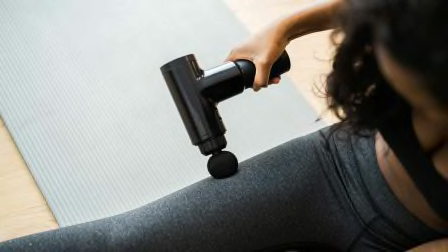Best Ways to Manage Knee Pain
Start with exercise, which is surprisingly effective. Plus, what to know about medications, injections, and surgery.

One in four adults live with knee pain, most often as a result of osteoarthritis. And cartilage—the cushioning between your bones—tends to become thinner over time.
The good news: Simple lifestyle tweaks can help delay further damage and increase knee function. In fact, research consistently finds that exercise is as effective as over-the-counter drugs for knee OA—and safer too, according to a recent meta-analysis published in the British Journal of Sports Medicine.
Why Exercise Works for Knee Pain
Physical activity compresses the cartilage, which can trigger a healing response in the cells, says Christopher Visco, MD, associate professor of rehabilitation medicine at Columbia University Vagelos College of Physicians and Surgeons in New York City. It can also strengthen the muscles around the knees, which can prevent further stress on the cartilage.
Other Ways to Ease Knee Aches
Apply heat if your knee is stiff in the morning and opt for ice when it feels warm and painful, says Visco. A brace may offer a sense of stability, but it won’t protect you from worsening symptoms.
Over-the-counter creams with ingredients such as menthol (Bengay and others) or capsaicin (Capzasin and others) may also reduce discomfort. And nonsteroidal anti-inflammatory topicals (NSAIDs), such as diclofenac gel, can reduce OA inflammation. Consider starting with creams instead of oral NSAIDs, which can lead to stomach trouble and increased heart risks. But use any NSAID judiciously, Visco says, because long-term use can damage organs or decrease joints’ ability to repair themselves over time.
Doctors typically don’t recommend opioids, says Savyasachi C. Thakkar, MD, chair of orthopedic surgery at Johns Hopkins Howard County General Hospital.
Be Cautious With Injections
Injections may offer temporary relief, but they’re not without risks.
Steroids can stave off inflammation for a few months, but they suppress the immune system.
Most research has suggested that hyaluronic acid injections don’t actually help with OA knee pain.
Studies are mixed on platelet-rich plasma injections, but a recent trial found that they don’t help more than a placebo. What’s more, insurance generally doesn’t pay for them, DiGioia says.
When You Need Knee Surgery
If knee pain is affecting your daily routines, other treatments aren’t working, and X-rays show a loss of cartilage in your knee, your doctor might recommend surgery. Some doctors perform arthroscopic surgery to remove a torn meniscus, a pad of cartilage that absorbs shock in the knees. But this type of surgery isn’t appropriate for people with osteoarthritis-related tears.
Studies show that for people with OA, repairing menisci is no better than physical therapy. Arthroscopic surgery can help younger people with injury-related meniscus tears, but trimming the torn meniscus doesn’t replace cartilage that’s deteriorated, says DiGioia.
Knee replacements are more effective, and they can significantly reduce pain. But they’re reserved for the most severe cases, where people have little to no knee cartilage left. A better option, when available, is early diagnosis and treatment.
Editor’s Note: A version of this article also appeared in the April 2023 issue of Consumer Reports On Health.




















